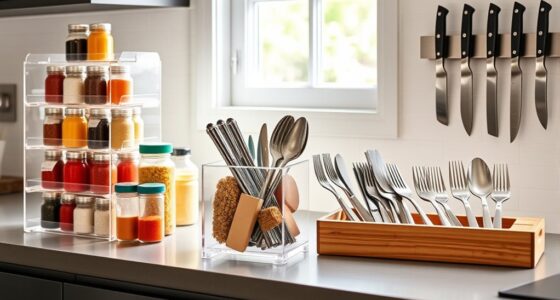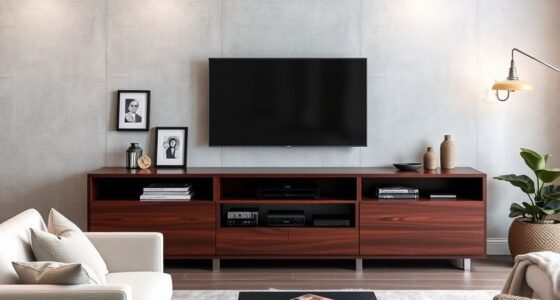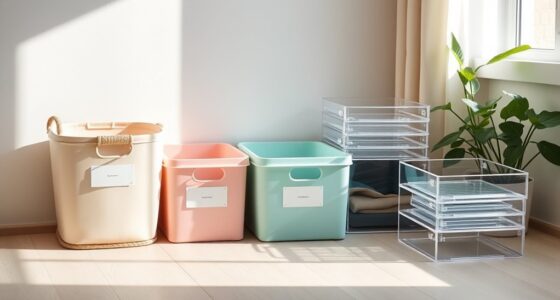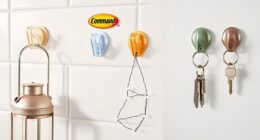When I decided to declutter, I found "The Declutter Challenge" and "The Sentimental Person's Guide to Decluttering" incredibly empowering. The former helps me get organized with structured steps, while the latter addresses my emotional attachments, making it easier to let go. Both tools emphasize community support, ensuring I don't feel isolated in the process. If you want to take control of your space like I did, there's so much more to discover about these methods.
Key Takeaways
- "The Declutter Challenge" provides a structured approach, breaking down the decluttering process into manageable steps to enhance organization.
- "The Sentimental Person's Guide to Decluttering" addresses emotional attachments, helping individuals navigate the psychological aspects of letting go.
- Both tools emphasize personal reflection, allowing users to understand their unique clutter challenges and develop tailored solutions.
- Community support in these guides fosters motivation and accountability, creating a shared experience that reduces feelings of isolation.
- Effective inventory methods from both tools simplify decision-making and promote long-term sustainability in maintaining an organized space.
The Declutter Challenge: A Guided Journal for Home Organization

If you're someone who struggles with clutter and feels overwhelmed by the chaos in your home, "The Declutter Challenge: A Guided Journal for Home Organization" is perfect for you. I found this journal incredibly motivating, especially when I faced setbacks like a house fire. The step-by-step approach helped me document my progress and understand my attachment to certain items. Reflecting on my experiences revealed why past organizing methods didn't work. This journal offers practical advice, tailored systems, and a supportive community that makes decluttering feel engaging rather than intimidating. It's a game-changer for anyone ready to reclaim their space!
Best For: Individuals seeking a structured and supportive approach to decluttering their homes while exploring the psychological aspects of their clutter.
Pros:
- Encourages personal reflection and understanding of individual clutter challenges.
- Provides a step-by-step approach that makes the decluttering process engaging and manageable.
- Fosters a supportive community, helping users feel less isolated in their organizing journeys.
Cons:
- May not fully address the specific challenges faced by individuals with chronic illnesses or disabilities.
- Some readers might find the journaling aspect less appealing if they're looking for quick solutions.
- The focus on personalized systems may not suit those who prefer strict cleaning methods.
The Sentimental Persons Guide to Decluttering
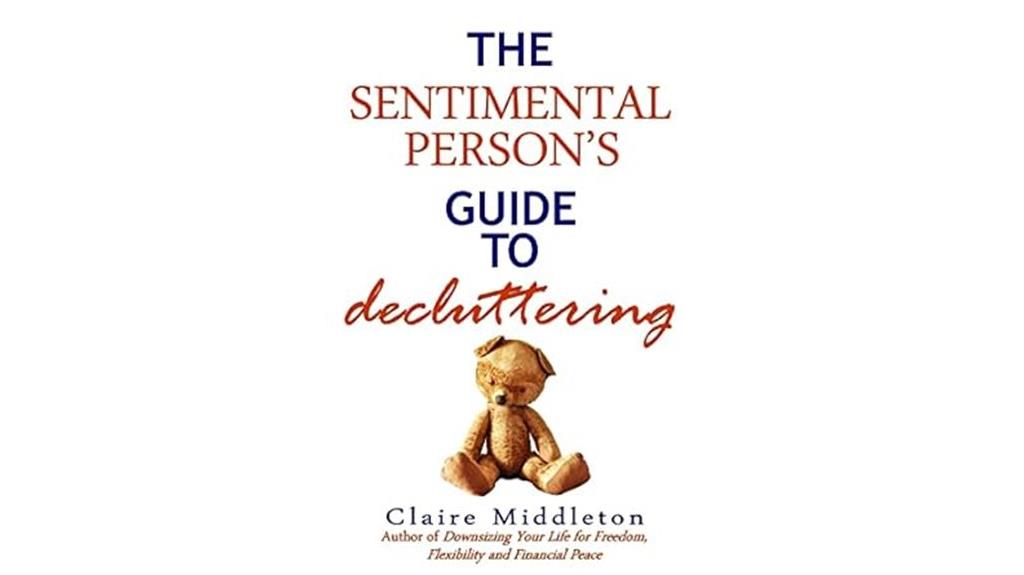
For anyone who finds it difficult to part with cherished belongings, "The Sentimental Person's Guide to Decluttering" is an invaluable resource. It motivates me to face the emotional challenges of downsizing. I learned to group similar items together, which made the process less overwhelming and helped me donate boxes of books I once clung to. The author addresses guilt directly, reminding me that gifts shouldn't feel like obligations. Sharing my clutter journey with others who understand has been comforting. This guide is a friendly nudge towards a minimalist lifestyle, making it easier to balance sentimentality and space management.
Best For: Individuals who struggle with emotional attachments to belongings and are seeking a supportive guide to declutter their space.
Pros:
- Motivational approach helps readers confront emotional challenges and encourages starting the decluttering process.
- Practical strategies for organizing items reduce feelings of overwhelm and promote effective inventory management.
- Relatable personal stories create a sense of community among readers, making the journey feel less isolating.
Cons:
- Some readers may find the content too basic if they are already familiar with decluttering concepts.
- The focus on emotional challenges might not appeal to those looking for more straightforward, minimalistic strategies.
- Readers seeking advanced organizational techniques may feel that the book lacks depth in practical applications.
Factors to Consider When Choosing The Decluttering Tools That'll Put You in Charge

When I think about choosing the right decluttering tools, I consider how they fit my personal style and needs. I also pay attention to my emotional attachments and how practical the tools are for everyday use. Plus, integrating community support and following step-by-step guidance can really help me stay on track.
Personalization of Tools
Choosing the right decluttering tools can greatly impact your organizing journey, especially since personalization is key to success. I've found that customizing my tools to fit my specific needs makes all the difference. For instance, using guided journals allows me to reflect on my unique clutter challenges and develop strategies that resonate with my experiences. I prefer focusing on group organization rather than tackling each room individually, which makes the process feel less overwhelming. Incorporating emotional support elements helps me manage the guilt of letting go of sentimental items. Plus, documenting my progress and celebrating achievements keeps me motivated. By personalizing my decluttering tools, I feel empowered to take charge of my space and create a system that truly works for me.
Emotional Attachment Awareness
Understanding my emotional attachments to belongings has been a game-changer in my decluttering journey. I've realized that many of my possessions carry memories and obligations tied to personal histories and family influences, which complicate my ability to let go. During this process, I've had "a-ha" moments when I understood that gifts or inherited items don't have to weigh me down with guilt. Recognizing these emotional ties empowers me to make informed decisions about what to keep. By confronting my attachments in a supportive way, I no longer feel isolated. This awareness helps me navigate decluttering with compassion, leading to a healthier relationship with my belongings and ultimately creating a more meaningful space in my home.
Practicality and Accessibility
Selecting the right decluttering tools can make all the difference in your organizing journey. I always consider how practical a tool is for my living situation—how much space I have and the volume of items I need to manage. Accessibility is key; I find it essential that tools are easy for anyone to use, regardless of physical ability. I prefer tools that offer clear, step-by-step guidance to help me track my progress without feeling overwhelmed. Personalization is also important; I want to adapt strategies to fit my unique clutter challenges. Finally, I choose tools that promote emotional understanding of my clutter, helping me work through any psychological attachments that might hinder my decluttering efforts.
Community Support Integration
While steering through the decluttering process, I've found that integrating community support can be a game-changer. Engaging with decluttering communities provides emotional support and shared experiences, making me feel less isolated in my organizing struggles. These resources encourage me to connect with others facing similar challenges, fostering a sense of belonging and accountability. When members share personal successes and tips, it motivates me to take action and celebrate my progress. Additionally, discussing emotional attachments to items in these groups helps me confront guilt and strategize letting go. Participating in forums or group activities reinforces that struggling with clutter is common, reducing feelings of failure and encouraging persistence. Community support truly empowers me on this journey.
Step-by-Step Guidance
When I tackle decluttering, having the right tools makes all the difference. Step-by-step guidance helps break the process into manageable tasks, making it feel less overwhelming. I love tools that incorporate structured frameworks; they encourage me to reflect on my emotional attachments to items, which deepens my understanding of my clutter challenges. Guided questions prompt me to document my thoughts and progress, boosting my motivation and providing that rewarding sense of accomplishment. It's essential to find personalized systems that cater to my specific household needs instead of following rigid methods. Finally, being part of supportive communities around these tools makes me feel less isolated, sharing experiences and encouragement with others on similar journeys towards home organization.
Organized Inventory Methods
Effective organized inventory methods are essential for taking charge of your decluttering journey. I've found that grouping like items—such as clothing, bedding, and books—helps create a clear inventory, making the process less overwhelming. A systematic approach simplifies decision-making, allowing me to prioritize what to keep, donate, or discard. Documenting my journey through journaling brings clarity to my emotional attachments, helping me track progress and understand why I hold onto certain items. Encouraging a step-by-step inventory method lets me focus on one category at a time, which fosters a sense of accomplishment as I see tangible results. Recognizing emotional ties to possessions helps me develop personalized strategies for letting go of what no longer serves a purpose.
Long-Term Sustainability Factors
After establishing organized inventory methods, it's important to contemplate how to maintain that order over the long term. I've found that choosing decluttering tools that can adapt to my changing needs is essential. Personalized strategies resonate with my organizational style, making it easier to stick to them. Regularly revisiting my methods helps me prevent clutter from creeping back in, creating a cycle of assessment and adjustment. I also acknowledge my emotional attachments to certain items; understanding these connections allows me to make mindful decisions about what to keep. Finally, having a supportive community keeps me motivated, as sharing my journey with others provides encouragement and accountability. These factors together truly empower me to sustain my decluttering efforts.
Frequently Asked Questions
How Long Does the Decluttering Process Typically Take?
When I tackle decluttering, the time it takes really varies. For small areas, I've found I can finish in a couple of hours. However, larger spaces or sentimental items often require days, or even weeks, to sort through. I've learned to set realistic goals and break the process into manageable chunks. It's all about finding a rhythm that works for me, so I don't feel overwhelmed or rushed.
Can Decluttering Tools Be Used in Small Spaces?
Decluttering tools can work in small spaces like a magician pulling a rabbit from a hat. I've found that even the tiniest areas can benefit from smart organizing solutions. Baskets and multi-functional furniture maximize storage without crowding. Using labels helps me keep everything in its place, making it easy to find what I need. So, yes, with the right tools, you can definitely take control of your small space and create a cozy environment.
What if I Feel Overwhelmed During Decluttering?
When I feel overwhelmed during decluttering, I take a step back and breathe. I remind myself it's okay to tackle one small area at a time. I set a timer for just 15 minutes to focus on a specific spot, which makes it feel manageable. I also play music to lift my spirits. Breaking it down helps me regain control, and I celebrate every little victory along the way to keep my motivation up.
Are There Any Tips for Maintaining a Decluttered Space?
Have you ever wondered how to keep your space clutter-free once you've decluttered? I've found that creating a daily routine helps immensely. I set aside just ten minutes each day to tidy up, making sure everything has a designated spot. I also regularly assess my belongings, asking if I really need each item. It's all about being intentional with what I keep and making small adjustments to maintain that fresh, organized feel.
How Often Should I Declutter My Home?
I've found that decluttering my home every season works best for me. It's a great way to refresh my space and reassess what I truly need. Each season, I set aside a weekend to go through my belongings. If I haven't used something in the past three months, I consider letting it go. It keeps my home feeling organized and helps me maintain a calm environment. What about you? How often do you declutter?
Conclusion
To summarize, finding the right decluttering tools can truly transform your space and mindset. Did you know that 54% of people feel more productive in a tidy environment? By using guided journals and understanding our emotional attachments, we can tackle clutter with confidence. Remember, it's not just about cleaning up; it's about creating a space that reflects who we are. So, let's take control and make our homes a sanctuary we love to live in!


